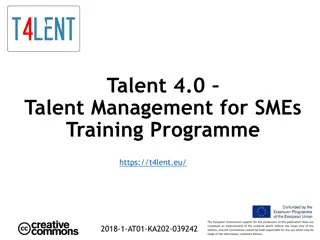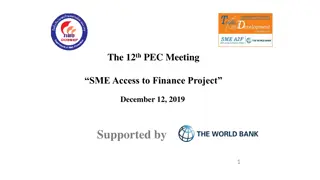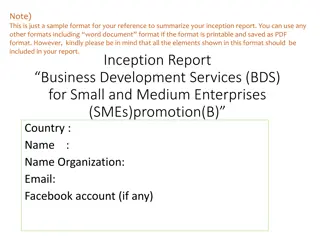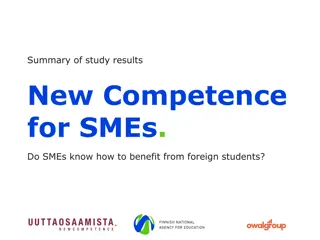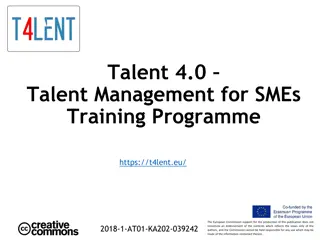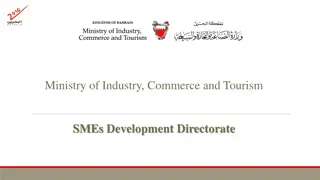Financial Insights on Prospects Opportunity for SMEs
Understanding the financial implications of providing equity to SMEs through the Prospects opportunity is crucial for their development. This includes exploring various financing tools, addressing the over-reliance on bank financing, and considering the benefits and challenges of utilizing Prospects. Key factors such as incentivizing financial reporting, brand promotion, and exit strategies should be carefully evaluated. Prospects offer a competitive and user-friendly alternative, with potential for increased transparency and market visibility.
Download Presentation

Please find below an Image/Link to download the presentation.
The content on the website is provided AS IS for your information and personal use only. It may not be sold, licensed, or shared on other websites without obtaining consent from the author.If you encounter any issues during the download, it is possible that the publisher has removed the file from their server.
You are allowed to download the files provided on this website for personal or commercial use, subject to the condition that they are used lawfully. All files are the property of their respective owners.
The content on the website is provided AS IS for your information and personal use only. It may not be sold, licensed, or shared on other websites without obtaining consent from the author.
E N D
Presentation Transcript
Listing at Prospects. Some tips from the financial angle. Malta Educational Clinic - 9/11 June 2016 Enrico Ambrogi Corporate Finance Consulting
The Prospects opportunity To provide Equity to SMEs is a pivotal topic in their development process; A number of Financing tools (from Debt to Equity Financing, mixed instruments etc) do cover different needs, planning horizons, and have different costs and implications (direct and indirect, e.g. centrale rischi ). The over-reliance of SMEs on Bank (ST) financing is a long standing, over-commented, feature of their relations with the financial markets. During the last decades countless papers have been written, and initiatives, institutions, alliances have been established to (try to) correct this (the magic word: undercapitalization). With limited avail. So, when introducing the Prospetcs opportunity, Pros, cons and some critical topics should be taken into account.
Plus A competitive tool (cheaper and simpler than other comparable proposals, e.g. AIM, or alternative instruments, e.g. minibonds) User friendly (logistic and environmental viewpoint) With a proper positioning (operations size, limits, possibility to multiple rounds to finance expansions etc). Mandatory incentive to continuously record and report financials to an international community, leading to: a. Increased transparency; b. Standardizing procedures. c. Organizational effort...
Plus_2 Brand promotion (automatically leading to an higher value...) Envisaging an Exit strategy (stronger than one-shot option, such as e.g. a traditional common private placement) for present shareholders (e.g. Generation change ). A way to set/consolidate/increase the company value, in the eye of banks, partners, clients...
Cons (again, not a mistake!) mandatory incentive to continuously record and present financial to an international community, leading to: a. Increased transparency; b. Standardizing procedures. c. Organizational effort Possible appeal of Prospects vis a vis other financial centres/markets Initiative still in a start-up phase (no case studies to be used as examples/promotion)
Key points SMEs selection: from the very beginning, to make a distinction between companies with good or poor chance to complete the process (due to corporate or personal reason, economic - and financial - performances, structural opacity, whatever). Understanding the sheer reason why... (new investments, consolidation (cash in on), mere value identification, perspective exit? etc): different reasons mean different viewpoints and expectations. Clear understanding of the market illiquidity (Prospects as a tool to reach certain goals, not a direct source of financing). Still, from the Prospects standpoint, opportunity to develop and increase its own visibility in the foreign markets (EU, middle East etc).
Key points_2 Stress the chance to reduce dependence on Bank financing (mostly, but not only, on short term basis, vis a vis medium/long term investment requirements...). Leading to financial education (it s the same old story, but still relevant...). Useless to say: room for consulting. Visibility (pro & cons...) Mutual understanding on company valuation fundamentals (best practice vs peculiar visions of the counterpart: NOT a foregone conclusion). Risk of dead end if the topic is not properly addressed. Sector-sensitivity of methodologies (e.g.: valuation in life science is different from the one in the real estate industry...). Reality vs promises (e.g.: what if the process reveals to be more complicated than expected in the eyes of the entrepreneurs). To stay on the safe side...
Role of the financial expert Make the entrepreneur understand that the company need to be a self-sufficient entity, the more it identifies with the founder/owner (in terms of functions, powers etc) the lesser the value. The increase of the company value has to be the key factor (the one perceived by the owner). Partnering with the company owners, focus on potential buyers from the very beginning (focused limited road shows?). Backing the company in the pre-listing stage, typically: multi-yearly industrial plan Planning of financial requirements and related sources How the shareholders are expected (or plan) to cash in on, over the planning horizon. .....







